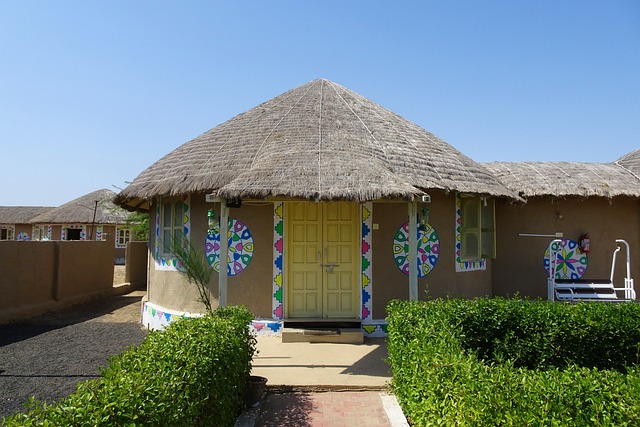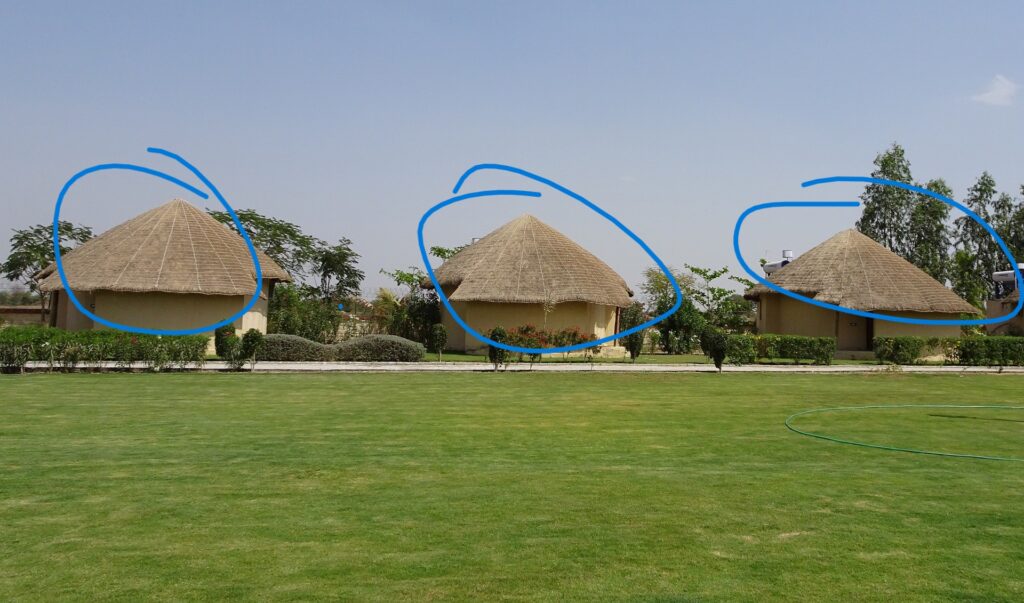Kutch bhunga is a traditional mud house that you’ll find predominantly in the Banni region of Kutch. With its unique circular design, the bhunga is both aesthetically striking and culturally significant. Once the traditional home of the Kutch people, these houses are now celebrated worldwide for their distinctive architecture and timeless beauty.
Table of Contents

History and Origin of Kutch Bhunga
The Kutch bhunga, a marvel of traditional architecture, has been around for centuries. This architectural gem reflects the ingenuity and resourcefulness of the Rabari, Ahir, and Meghwal tribes, who have lived in the arid and semi-arid landscapes of Kutch for generations. Constructing a bhunga was cost-effective because the materials—mud, grass, and wood—were locally sourced and inexpensive. This made the bhunga an accessible and sustainable option for the communities.
Kutch Bhunga: The Heart of Kutch’s Heritage
Bhungas are more than just homes; they are a symbol of Kutch’s rich cultural heritage. Before the 2001 earthquake, these mud huts were a common sight in the Kutchi landscape. Though many were damaged in the quake and modern influences have led to a decline in their use, the bhunga remains a cherished icon of local tradition.
Architectural Features of Kutch Bhunga
The Beauty of Circular Design
The circular shape of the bhunga isn’t just for show—it’s a practical feature that enhances its structural integrity. This design is well-suited to withstand the region’s seismic activity. The bhunga’s aerodynamic form also ensures excellent ventilation and stable temperatures, keeping interiors cool during hot summers. Thick mud walls further help in maintaining a comfortable climate year-round.
Materials Used in Kutch Bhunga

The construction of a bhunga primarily involves mud and wood. About 90 percent of a bhunga is built from these materials. Mud forms the thick walls, while wood is used for the roof structure. Lightweight wood is preferred for the roof to ensure durability. Additionally, thatch, typically made from locally available grass, is used to cover the roof. This thatched roof not only aids in water drainage during the monsoon but also provides extra insulation.
Kutch Bhunga: A Tourist Attraction
A Unique Experience
The Kutch bhunga has become a major tourist attraction, drawing visitors with its exceptional architecture and cultural significance. The sturdy circular shape and innovative design reflect the region’s advanced engineering knowledge. Tourists are often captivated by the bhunga’s interior, which is adorned with beautiful accessories made from glass, cloth, and wood.
Visitors to a bhunga can experience a blend of modern comfort and traditional charm. Modern amenities, including a double bed, air conditioning, and other conveniences, make it an inviting place to stay. The bhunga’s unique appearance, with its decorated mud walls and circular thatched ceiling, offers a peaceful retreat that beautifully combines the old with the new.
Bhungas at the Rann Utsav
If you are planning to experience living in a Bhunga (traditional kitchen) made of glass, you should know this: The Bhunga you see in Ran Utsav is not a traditional Bhunga experience. The human body in glass is equipped with very simple features, almost like a hotel room or even better. If you are staying in Bhunga during summer festival, then you will only experience the structure of Bhunga because it will not be experienced in the original, traditional Bhunga.
Bhunga and Luxury
Ran Utsav Mein Bhunga and Kandeeshaning come with a very comfortable bed and many modern conveniences which cannot be found in the traditional Kachchh Bhunga. Often, these buildings are constructed using cement blocks and plaster instead of mud and stones. So, if you are thinking that you will have a standard Bhunga experience, then this is not entirely true. By using it, you will have a similar experience as in a hotel room, but you will definitely get a different glass cultural feel.
Where is Bhunga house located?
Mainly, Bhunga houses are located in Kutch’s Banni area, which is mostly populated by the Jatt community. This community has been carrying the heritage of Kutch for many years. However, most people have forgotten the Kutchi culture and are living a modern life as much as possible. If you want to visit Kutch and experience living in a Bhunga, you must visit during the Rann Utsav. This way, you can experience staying in a Bhunga house with modern facilities.
In many rural areas of Kutch, you’ll find bhungas in a variety of styles and structures. Nowadays, people are not building new bhungas, as we have access to advanced technologies for constructing houses. However, bhungas were once an integral part of Kutch’s heritage.
Bhunga House PDF – How Kutchi Huts Are Built
Click here Check out some beautiful photos of Bhungas.
Come and experience the magic of Kutch. Remember, “Kutch nahi dekha to, kuch nahi dekha.”
For more information about Kutch and its enchanting bhungas, visit us at [KutchTourism.in]
Pingback: Explore Rann Utsav 2024-25: Dates, Events, and activities
Pingback: Threads of Banni: The Enduring Spirit of Kutch’s Women Artisans - Rtefacts